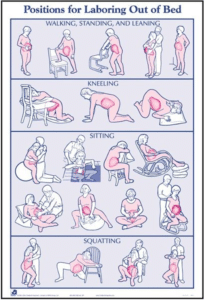During the second stage of labor, when pushing happens, your body actively works to bring your baby into the world. This stage is often the most intense. Even women with an epidural may feel pressure and a significant sensation change.
What is the traditional labor position?
Over the last 50 years in the U.S., most women have given birth while lying in the lithotomy position (laying on their back with their knees bent and raised in the air), similar to when having a pap smear done. Their healthcare providers would tell the woman when to start pushing and to try to “hold” the push, and then when to relax. Although this position may be convenient for the healthcare provider supporting the delivery, it may not be the best position for the mother as you don’t have the assistance of gravity.
Are there options for various positions?
During the second stage, you may feel like laying on your back, but there are other positions too that you can explore if you would like to do so. Some women deliver while on their hands and knees with their backs raised, while others may give birth while laying on their side, sitting in a tub of water if doing a water birth, or using something or someone to help them squat or stand while pushing. What is essential is for you to do what feels best for you during this part of your labor. Sometimes your healthcare provider may recommend changing positions if your baby is experiencing increased stress or if the baby’s descent is slow.
Is there a certain position that is considered “the best”?
The “best” position depends on you and your baby. Your Certified Nurse Midwife, physician, or nurse will let you know if there is a specific position they recommend due to a need to monitor your baby in a particular manner, or if your baby is experiencing increased stress due to a particular position. Also, there may be instances when your healthcare provider asks if you can lay in a lithotomy position if that is the best position for them to assess how your baby is descending in your pelvis or if it ends up being recommended that a doctor helps you by using something to help gently pull while you push to get your baby out (e.g., vacuum or forceps).
Coaching vs. no-coaching for pushing, what’s the difference?
Some women appreciate direction as to what position may help their pushing efforts. Especially for women with an epidural who may not fully feel their contractions, having someone monitor the uterine contraction so that voluntary pushing occurs in conjunction with the uterus can be beneficial. Other women may prefer to follow their body’s urges to push and not want verbal directions.
Should I turn the lights up or down?
While pushing, you may want the lights low and voices down, to keep it as calm as possible. Others prefer brighter lights and a higher level of energy. Some women want to use a mirror to see their baby’s head as it prepares to exit their body, some women like to reach down and feel the baby’s head, and others want to close their eyes or focus their gaze elsewhere.
Just ask us!
Just as every woman is different, every woman’s experience of their second stage is different. We want to know what is best for you. If you think it may feel better to be in a different position, just ask. If you planned on having the lights dim, but now you would like them turned on and to try to see your baby’s head with the mirror, just let us know. We are here to support you every step of the way.




